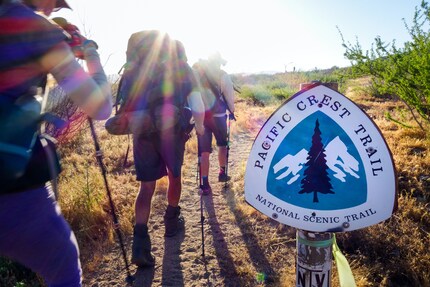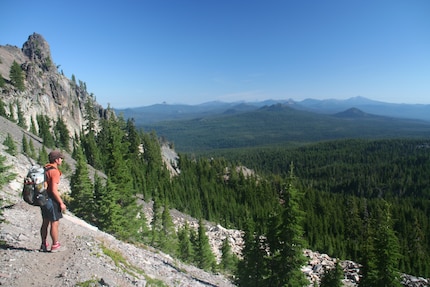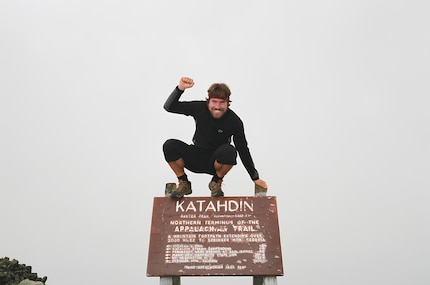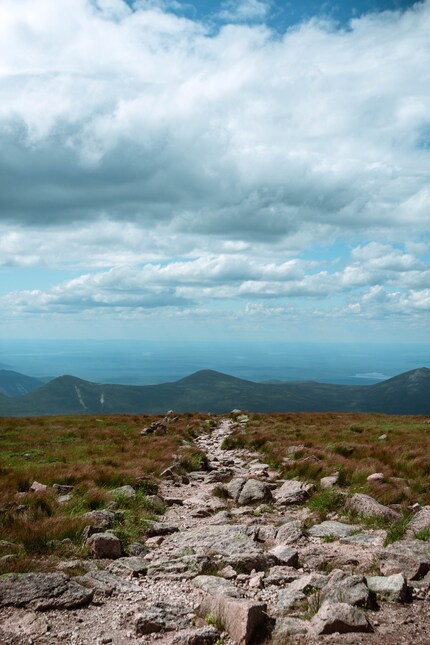
Background information
A step in the right direction: importance of equipment and interesting encounters on long-distance hikes
by Siri Schubert

Pacific Crest Trail, Appalachian Trail – the names alone have a magical ring to them. For long-distance or thru-hikers, they’re both a dream and a challenge. Carsten Jost has walked both trails.
Carsten Jost has covered 4,240 kilometres on foot in the USA. Equipped with a backpack, a tent and not much else. He’s also frequently out and about on longer hikes in Europe, such as the GR11 in the Spanish Pyrenees stretching from the Atlantic to the Mediterranean. The hikes he’s currently planned are closer to where he lives and shorter. After all, the Alps still hold many one- to two-week trails that appeal to him. The experience he gained in the USA also helps him on trails in European climes.
To share his passion for the outdoors, he offers classes and tips on fastpacking (website in German). He’s also a speaker at German Trail Days held in November and is planning more workshops for the coming year.
You’re an ultralong-distance hiker. What does that mean?
Carsten Jost: Well, I’m not sure there’s a definition of what «ultra» means in hiking. A few years ago, I was hiking trails equipped with a backpack and tent and covering several hundreds, sometimes even thousands of kilometres. These days, my hikes are shorter.
You’ve hiked the Appalachian Trail, which spans more than 3,500 kilometres – all the way from Georgia to Maine. You’ve also done the Pacific Crest Trail that winds its way from the US-Mexico border to the US-Canada border for 4,270 kilometres. How long did they take you?
They both took about five months.
What were the highlights?
Sunrises, sunsets, making new friends and watching animals in the wild. The list is endless. When your day consists of eating, sleeping and walking, there’s plenty of room to take pleasure in things you might not notice otherwise. I’m quoting Christine Thürmer, by the way. The most-hiked woman in the world.

What were the most important lessons you learned along the way?
That some things can’t be changed. Only the way you deal with them. And that you’re capable of much more than you think if you have a goal you’re working towards day by day, step by step.
What inspired you to go on these long hikes?
A trekking tour on the West Coast Trail on Vancouver Island in Canada. It was the first time I truly experienced the wilderness, and I wanted more.

What’s your next adventure on foot?
I’m now married with two children, a house, I’ve planted a tree ... the whole shebang. Some day, I’d like to do the Continental Divide Trail in the USA or the Gröna Bandet in Sweden. More realistically, however, it will probably be the «Grenzgängerweg» in the Allgäu in southern Germany. It takes about six days.
How will you prepare for it?
I didn’t use to prepare at all. I’d suffer a bit during the first few weeks, but then it would be fine. These days, I’d start preparing a few months before and start doing longer hikes close to where I live on the weekends.
What about your equipment?
I carry what you’d call ultralight gear. A super light down quilt, which is a down blanket, no sleeping bag. An ultralight backpack without a frame, a single-wall tarp tent, which is a cross between a tarp and a tent and a very light inflatable sleeping pad. And as little as possible of everything else.

How have you adapted your equipment over time?
I think I went through the standard phases of equipment before wising up a bit. I started out packing lightly and soon realised, especially on extensive hikes, that you can pack even lighter. Then there was the phase when I was no longer able to cut back on weight by leaving it out, but could only do so by investing in the latest, hottest equipment. These days, I still appreciate a lightweight backpack, but I don’t get annoyed when my packing list isn’t ultralight.
Let’s say I wanted to hike and bivouac for a week or two in the autumn. What advice would you give me?
This is a tricky question, because autumn can be a very pleasant season when the sun’s out or quite nasty when it rains. How lightly you should pack in this case depends on the weather as well as your skill.
What type of equipment would I need? How should I prepare?
In essence, I’d go for standard, ultralight gear suitable for three seasons. There are countless packing lists available online you can use as a guide. In any case, one thing’s great about autumn. There are no mosquitoes! So in good weather conditions, you can confidently travel with a very light tarp.
What misconceptions are there about long-distance hiking that you’d like to correct?
You can do them at any age and you don’t have to be super athletic. I met people in their 60s on the Pacific Crest Trail. They finished the trail just like I did. There were couch potatoes, too, who simply got fitter along the way. Just start walking if you’re up for it. Ultralight equipment isn’t a must-have in this case, but it does help. You can often make your conventional equipment light enough for a long-distance hike by leaving a few things behind.

What would you recommend someone who wants to get into long-distance hiking but doesn’t quite know where to start?
I think most people who want to get started with long-distance hiking either have a strong hiking or trekking past like I did, or a very strong desire to do something along those lines. Ultimately, the biggest obstacle with long-distance trails is to get going, to invest that time. Taking several months off is a lot more hassle than, let’s say, spending a few hundred euros on a super-light rain jacket at an outdoor store. So my advice is: find a trail you like the look of, look for people who’ve already walked it and who’ll encourage you. If you want to walk the Way of St. James, it’s not very helpful if someone tells you another trail is much nicer. Just let your heart guide you.
What are typical beginner mistakes to avoid?
Answering this is always a bit of a balancing act (grins). I consider using heavy equipment a rookie mistake. However, ultralight equipment that’s not used properly because of inexperience is just as bad. Overdoing the walking right at the start can lead to injuries, so that’s not a great idea either. Having said that, covering stretches that are too short is also problematic, as it will take you longer to reach the next supply point. Which means you’ll have to lug more food. I think my biggest rookie mistake was my conviction that I knew exactly what I was doing (laughs). I didn’t, by the way.
Header image: Carsten Jost
Research diver, outdoor guide and SUP instructor – I love being in, on and around water. Lakes, rivers and the ocean are my playgrounds. For a change of perspective, I look at the world from above while trail running or flying drones.
Interesting facts about products, behind-the-scenes looks at manufacturers and deep-dives on interesting people.
Show all
Background information
by Siri Schubert

Background information
by Siri Schubert

Background information
by Siri Schubert